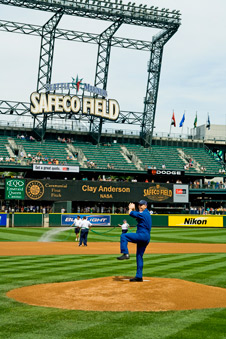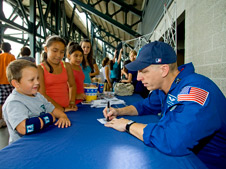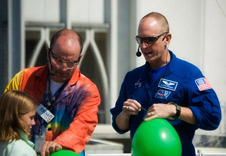Feature
NASA Hometown Heroes 2008: Spacious in Seattle
08.22.08
 Astronaut Clay Anderson throws out the ceremonial first pitch at a Seattle Mariners game to help promote NASA’s 50th anniversary , the International Space Station’s 10th anniversary and NASA’s future to send humans to the moon and beyond. Photo credit: Seattle Mariners
Astronaut Clay Anderson throws out the ceremonial first pitch at a Seattle Mariners game to help promote NASA’s 50th anniversary , the International Space Station’s 10th anniversary and NASA’s future to send humans to the moon and beyond. Photo credit: Seattle Mariners
 During the Seattle Mariners baseball game, space fans got the opportunity to get an autograph by astronaut Clay Anderson, as well ask questions and get photos. Photo credit: Seattle Mariners
During the Seattle Mariners baseball game, space fans got the opportunity to get an autograph by astronaut Clay Anderson, as well ask questions and get photos. Photo credit: Seattle Mariners
 Astronaut Clay Anderson gets some help from a member of the audience as he assists in demonstrations of rockets and propulsion as part of the Seattle Pacific Science Center’s Danger Science. Photo credit: Pacific Science Center
Astronaut Clay Anderson gets some help from a member of the audience as he assists in demonstrations of rockets and propulsion as part of the Seattle Pacific Science Center’s Danger Science. Photo credit: Pacific Science Center
Recently the city of Seattle, Wash., extended its connection to space beyond the Space Needle tower when it received a visit from astronaut Clay Anderson.
Anderson’s trip to the “Emerald City” aimed to help better inform the public about NASA’s 50th anniversary, the International Space Station’s 10th anniversary and NASA’s future of going to the moon and beyond. As a five-month resident of the space station in 2007, Anderson was able to share his experiences living and working aboard the orbiting laboratory as a flight engineer to conduct science experiments and spacewalks.
Anderson kicked off the festivities by throwing out the ceremonial first pitch for the Seattle Mariners baseball game win against the Minnesota Twins. Game goers also got a chance to meet Anderson for autographs and photographs. In addition, Anderson presented a photo of Seattle taken from the space station to the Mariners’ CEO Howard Lincoln.
“From the kids receiving autographs all the way up to the CEO receiving the photo of Safeco Field from space, everyone in attendance enjoyed having Clay out to the game,” said Mariners Marketing Coordinator Mandy Sundblad.
"You could definitely tell that it didn't matter what age they were, people were intrigued by the presence of an astronaut and the concept of space in general. His presence on the concourse was the biggest turnout for an autograph session the Mariners have had all year, and I'm certain that we would love to work with NASA in the future.”
Aside from participating in an American pastime, Anderson did a couple of media interviews before making an appearance at Seattle’s Pacific Science Center. In between autograph sessions, Anderson helped teach groups of children about astronauts and space exploration under the blanket of stars and planets projected on the domed ceiling of the science center’s Planetarium.
For 8-year-old Lucas, meeting Anderson was a connection to the past.
“It was really fun. I learned how fast the space station goes around the Earth. I think about being an astronaut because I like space. My grandpa knew a bunch of astronauts like Gene Cernan,” said Lucas, whose grandfather met several astronauts while touring as part of a folk music group.
Anderson also did some hands-on science demonstrations as part of the center’s Danger Science Show to illustrate the power of explosions, rockets and propulsions. Among the rudimentary rockets at his disposal were balloons, 35 millimeter film canisters and soda liter bottles. Anderson assisted in filling each of the rockets with the proper fuel, air, water, and liquid nitrogen to launch them. The down-to-Earth launches were welcomed by laughter and applause from the audience and helped launch a new generation of explorers, such as 6-year-old Chandler, who responded with eyes open wide, “It was cool!”
Johnson Space Center, Houston